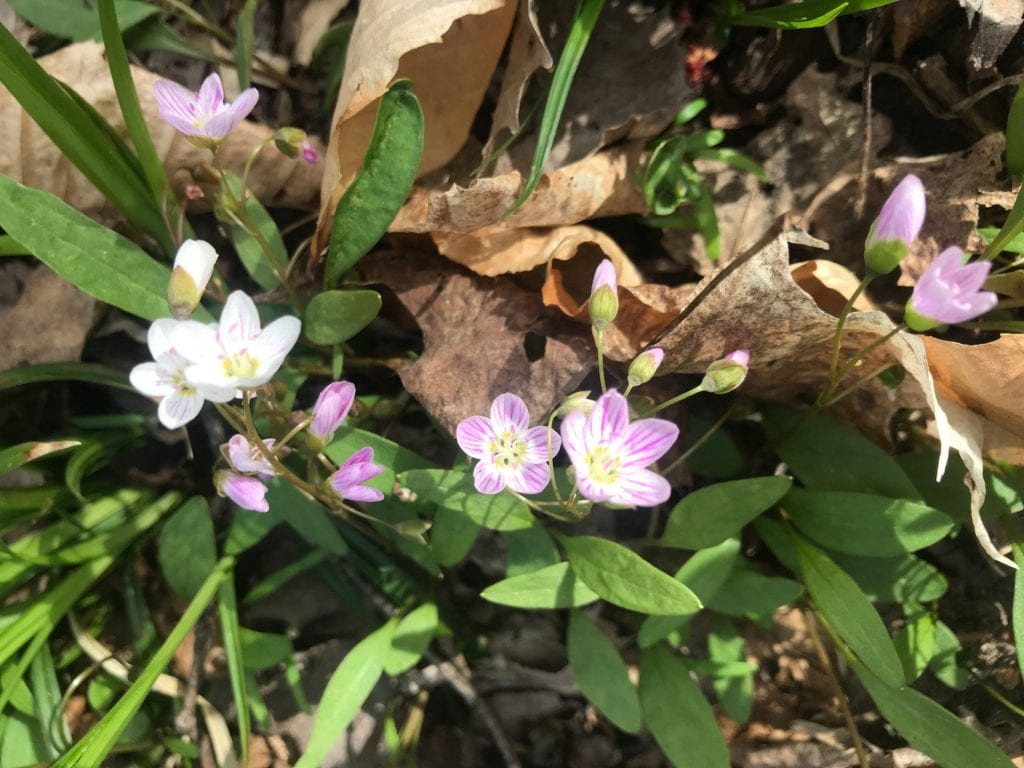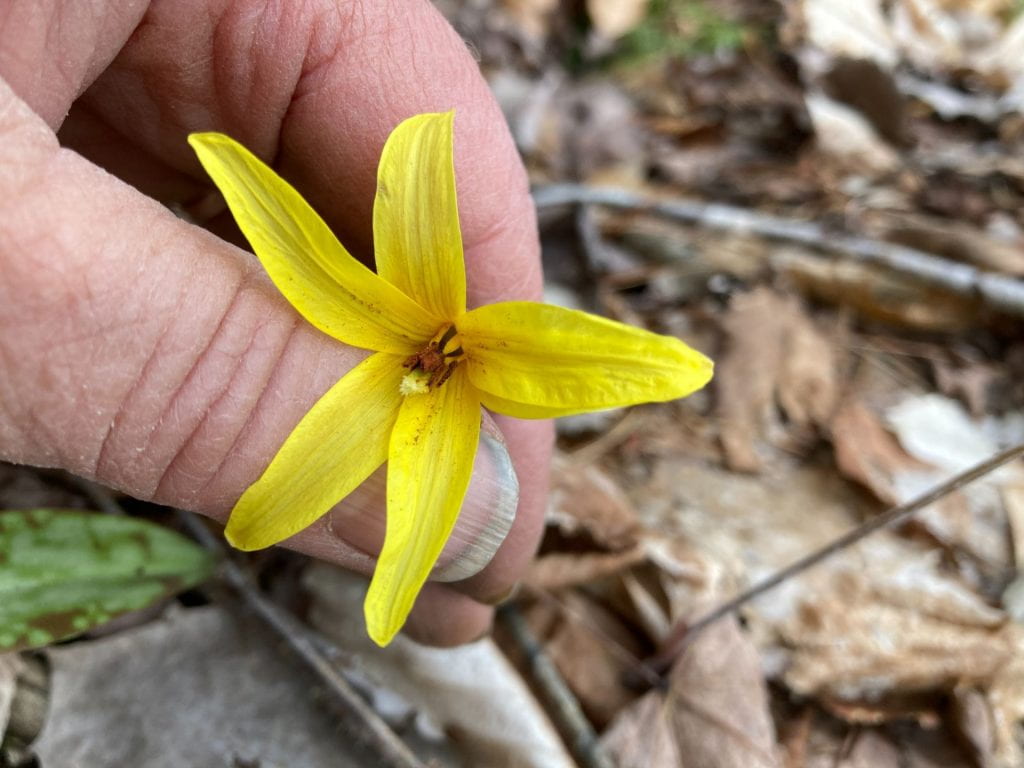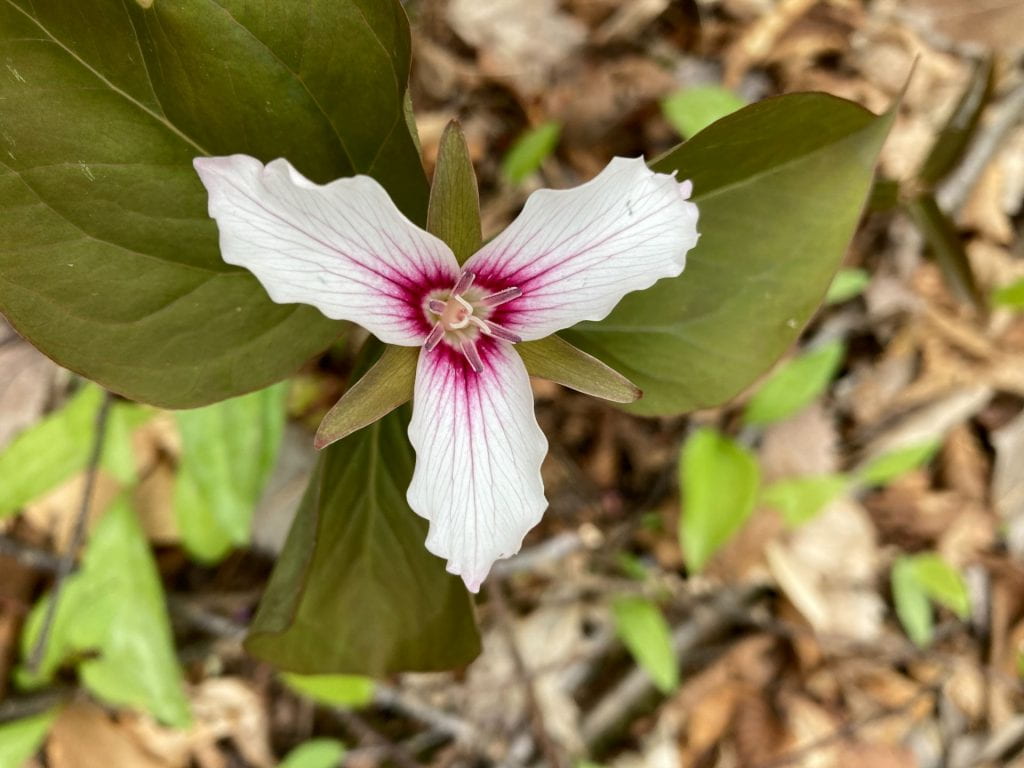When I was asked to write a post on ephemerals, I had never recognized the word as applying to woodland flowers. In my mind, ephemeral was infused with the meaning of ethereal. It is fun to have clearly delineated definitions for both words now, though ethereal also seems quite applicable to the lovely wildflowers spring gifts us with!
Ephemeral describes some of our short lived woodland flowers that emerge in the spring, poking up from under the dead leaves. Though they blossom and die back quickly, they are a treat forest walkers look forward to this time of year.
When average air temperatures reach the low 50s, one of my favorite flowers blossoms: Spring Beauties. There are two related types of this perennial. Claytonia virginica, also known as Eastern Spring Beauty or Grass Flower, has grass-like foliage. Claytonia caroliniana foliage has a rounder, broader leaf and also goes by Carolina Spring Beauty. The common names Fairy Spud and Spring Beauty can refer to either and the flowers are virtually identical in these two species.

The 4-6 inch plant has blossoms that are lovely and quite diminutive. The color ranges from almost white to pinkish with pink stripes on the petals and a small yellow center.
Spring Beauty grows from a small rhizome, which is edible (hence the name fairy spud). These starchy rhizomes are about the size of a peanut, and said to taste like a cross between potato and chestnut. A meal would require the decimation of a fairly large patch of flowers, so perhaps it is best to forgo the experience!
Medicinally, Spring Beauty was purportedly used by early people as a contraceptive, a treatment for seizures, sore throats, dandruff, urinary tract problems and a poultice for eye infections. The plants can be propagated by planting the rhizome, or by collecting the triangular seed pod when it turns brown. The pod will virtually explode when it is mature and eject the seeds several feet, so if collecting seed, be sure to contain them! The seeds should be planted as soon as possible after ejection. They require two warming/cooling cycles to germinate. If planting them right away, they will not germinate until next year. It takes 2 – 3 years for the plant to mature enough to flower.
Another lovely ephemeral species is the Trout Lily (Erythronium americanum). As the common name suggests, the plant is part of the lily family. Yellow is the most common bloom color, and the plants are also known as Adder’s Tongue, Fawn Lily, or Yellow Dog Tooth Violet (the corm looks like a small dog tooth, but the plant is not a violet.)

These are perennial colony-forming plants with olive colored, speckled leaves which resemble the speckling on a brown trout. It takes several years for corms to mature enough to produce a flower, so you will see many leaves in the colony but few flowers. The flowers are droopy in cloudy weather which makes them difficult to see (the underside of the flower is darker, and tends to blend in with the foliage.) It is easiest to spot the flower when the sun is out, as the petals curl back to reveal the bright yellow interior.
There are over 30 varieties of Trillium. These are instantly recognizable with their three-petaled flower and prominent 3 leaves beneath the flower. Trillium are perennials that also belong to the lily family. They blossom in late spring / early summer. Not surprisingly, they prefer deep shade and acid humus.

My woodland in Colton produces many, many Red Trilliums, and an occasional Painted Trillium (Trillium undulatum). Undulatum refers to the “undulating” wavy edge of the flower. Painted Trilliums are white, with a splotchy red throat. When any Trillium flower is picked, it can take the plant 2-3 years to recover enough to produce another flower. Unlike most flowers, the Trillium only produces one seed. Beware, their berries and rhizomes are poisonous!
Bloodroot (Sanguinaria canadensis) is a stunning early native perennial that emerges in late April and can last into summer. Also called Bloodwort, Indian Paint, Puccoon, and Red Puccoon, this whole plant contains red sap, but most impressively in the rhizomes. The sap contains irritating compounds, so gloves should be worn if handling any part of the plant, especially the roots. The plant produces a pretty, bright white flower, usually having 8 petals. Bloodroot was used medicinally by indigenous people for a variety of clinical conditions, but is not recommended due to alkaloid irritants in the sap.

These flowers are short-lived treasures hiding in nearby spring woodlands, so if you’re out on the trails in the next few weeks, keep your eyes peeled!
Laurie Gilbert-Smiley has been a Master Gardener since 2018. In addition to her cottage garden, she keeps bees on her property in South Colton. She volunteers in the gardens of the Extension Learning Farm, including the new Pollinator Garden.
